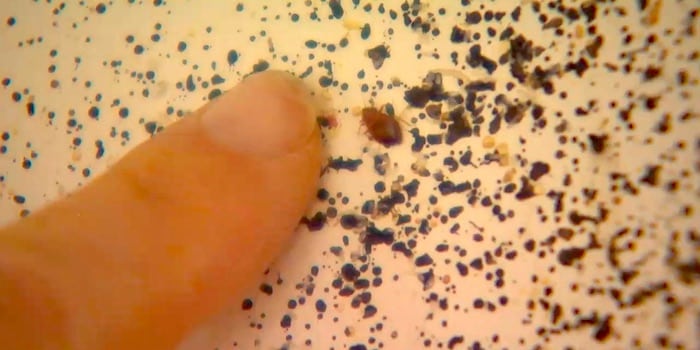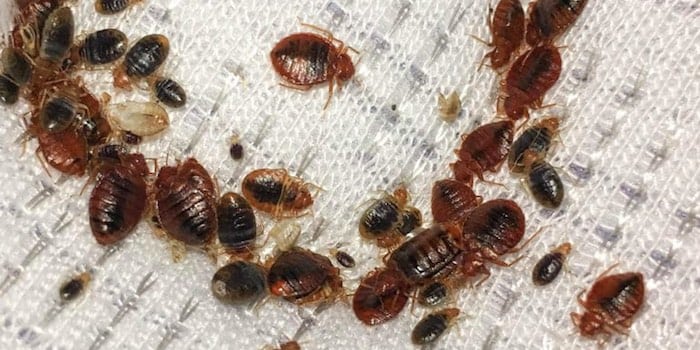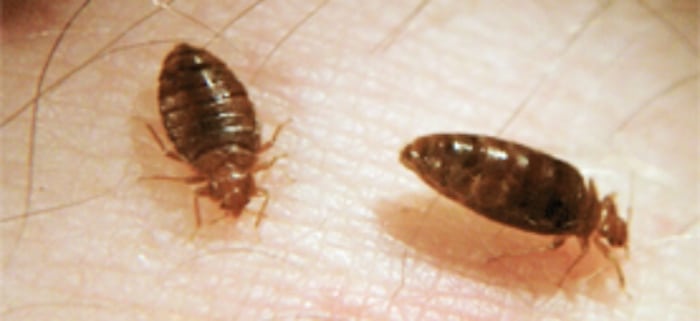
Bed bugs are pests that are tough to get rid of. They’re really good at hiding, and they reproduce quickly. Plus, bed bug eggs are resistant to many forms of treatment, so a one-time treatment might not be enough to get rid of your bed bug problem.
If you think you might have bed bugs, don’t burn the entire house down just yet. We’ll walk you through how to get rid of bed bugs, including where to find them, what they look like and how to get rid of them for good.
How to Get Rid of Bed Bugs:
**Click to auto scroll by section
Section 1: How Do I Get Rid of Bed Bugs?
It might be tempting to fly into a bed bug killing rage and start spraying everything in sight. Although it might feel good in the moment, doing that is a waste of time and money.
When you live with a lot of clutter, this makes it easier for bed bugs to hide and harder for you to get rid of them. Since things like books, children’s items, boxes, and electronics can’t be treated with insecticides, bed bugs end up with plenty of places to hide for safety. Clean up cluttered areas before treating with chemicals.
There are some steps you need to take in order to prepare for treatment first if you want to completely get rid of your bed bug problem. You need to follow these steps whether you will be doing the treatment yourself or hiring a professional.
Get Rid of Clutter
Get anything except for large furniture out of the room. Items from the infested area can transfer bed bugs to other areas of the house, so you should store them in tightly sealed plastic bags with Nuvan Strips to kill any bed bugs.
Wash Infested Clothes & Bedding
Infested clothes and bedding can’t be treated with insecticide. Wash them in hot water that’s at least 120°F in order to kill any bed bugs. You might want to run them through twice, just to be sure.
Break Down Bed Frames
Taking apart bed frames in infested areas usually exposes bed bug hiding spots, and being able to get to these places while cleaning is extremely important. Stand the box spring on its side and shine a flashlight through the fabric to check for bed bugs. If the fabric is torn, take the fabric off to prepare for spraying.
Need bed frame haul away?BOOK A PICKUP ❯
Remove Drawers
Take out any drawers from desks, chests, or dressers since bed bugs like to hide in these places. Turn the furniture over so you can easily inspect and clean any hiding spots. All furniture in the room should be pulled away from the walls.
Clean Infested Areas
Scrub any infested surfaces with a stiff brush to get rid of any bed bug eggs and vacuum the room thoroughly. Use an attachment to carefully vacuum cracks and crevices in furniture, along baseboards, and on the walls.
Thoroughly vacuum baseboards, furniture, bed stands, rails, headboards, footboards, bed seams, tufts, buttons, edges of the bedding, as well as the edges of the carpets, and anywhere else you can possibly think of.
A thorough vacuum cleaning can remove particles from cracks and crevices so that insecticide can get in more deeply. Bed bugs hold on tightly to surfaces, so vacuum by repeatedly scraping the end of the attachment over the infested areas to suck up the bed bugs.
Don’t use a bristle or brush attachment, because you could transfer bed bugs to other areas since they will cling to the brush. When you finish vacuuming, make sure the vacuum bags are tightly sealed and throw them in a garbage can outside, away from your house.
Section 2: Bed Bug Facts & Prevention
Wondering how they even got there in the first place? While you might be happy knowing how to get rid of bed bugs, keep reading to learn about where bed bugs come from, what they look like, what kills them, and what you can do to avoid a future infestation.
What Causes Bed Bugs?
You may find this surprising, but bed bugs aren’t caused by being unclean. While a cluttered home gives them more places to hide which can quickly lead to an infestation, bed bugs can live in both clean and dirty environments.
Bed bugs come from a variety of places and are often unknowingly brought into your home. They can attach themselves to a person and ride right into your house without being seen.
Even though it is helpful to understand exactly what causes bed bugs, it’s more important to know how to identify them, find all their hiding spots and ultimately get rid of them.
🐞 Want more about how those pesky bed bugs got to your home? This is the blog for you.
What Do Bed Bugs Look Like?
Bed bugs can be seen with the naked eye, but they’re so small that you may want to use a magnifying glass when looking for them. Adult bed bugs are a reddish-brown color, flat, oval-shaped, wingless, and about 4 to 5 millimeters long (about the size of a red ant).
Because they’re flat, bed bugs are able to hide in most cracks and crevices. You don’t get any eggs on you while you’re sleeping in bed, but the eggs can be found on surfaces close to where you (the host) sleep.
Lesions, red spots, and intense itching are symptoms of bed bug bites.
Even if you can’t find bed bugs, find their hiding spots by looking for bits of fecal material.
What do bed bug feces look like?
Bed bug feces and blood spots are rust-colored and get left on your bedding when the engorged bed bugs are crushed. Because bed bugs like to hide in cracks and crevices during the day and come out to feed on the host’s blood while they’re sleeping at night, these rusty spots are a sure sign of a bed bug infestation.
🔎 Need to know more details? Read our in-depth guide to identifying bed bugs and their bites.
Where Do Bed Bugs Hide?
When checking your home for bed bugs, inspect any place that would offer them darkness, isolation, and protection. You should also check rooms next to where an infestation is found.
Bed bugs like to hide along the piping on the edges of a mattress and live within a few feet of where people sleep. There are a few signs you can check for to confirm a bed bug infestation.

The Mattress & Box Spring
Check the mattress carefully, checking the seams and tufts along the edges. Flip the mattress and look at the bottom closely as well, paying close attention to any tears in the fabric. Look at the fabric on the bottom of the box spring and shine a flashlight to make sure the bed bugs haven’t gotten inside of the box spring.
Bed Frame, Headboards, Footboards
Take the mattress and box spring off of the bed frame and shine a flashlight over every possible hiding place on the bed frame. Keep in mind that bed bugs can fit into a crack as thin as the thickness of a business card.
Other Furniture
Take out all of the drawers and cushions from the furniture in the room. Carefully check all the seams, cracks, and crevices with a flashlight, just like you did with your bed. Work slowly and thoroughly, because bed bugs are often found in these spots in an infested room.
Is your furniture worn out?BOOK A PICKUP ❯
Walls & Carpet
Remove any switch plates, outlet covers, and wall hangings so you can check for bed bugs in and on the walls. Look under threshold strips and behind baseboards or moulding if possible. Shine your flashlight into any cracks in the plaster and seams along any wallpaper.
Electronics & Appliances
Unfortunately, electronics and appliances can be a perfect hiding place for bed bugs. Inspect them closely with a flashlight and magnifying glass too, removing them from the room if at all possible. You can put them in a well-sealed bag with Nuvan Strips to kill any bed bugs inside so you don’t have to replace them with new devices.

What Kills Bed Bugs?
You might be able to get rid of bed bugs with natural, home remedies, depending on the stage of the infestation and how bad it is. However, if the bed bugs have settled in, these methods probably won’t work.
You can buy insecticides from stores, but they’re usually not strong enough to get rid of a bed bug infestation. If this is the case for you, you’ll probably do better to call an exterminator or other pest control pro.
This is why you can’t rely solely on insecticides to get rid of a bed bug problem. Even pest control professionals have started relying on a variety of natural methods to help get rid of bed bug infestations.
Here are some home remedies that can be used to get rid of bed bugs on your own:
- Rubbing Alcohol. To kill bugs on contact, pour rubbing alcohol into a spray bottle and spray directly on bed bugs.
- Scented Dryer Sheets. A temporary solution, scented dryer sheets can drive bed bugs out of their current hiding spot.
- Baking Soda. Sprinkle directly on areas of infestation.
- Hair Dryer. The heat of your hair dryer will kill bed bugs. Blast the area directly on the highest heat possible.
Steam Cleaners
Steam cleaners can get into cracks and fabrics, so you can use them to treat carpet, rugs, baseboards, bed frames, and other furniture. The steam temperature needs to be at least 130°F, but you need to use the diffuser or the bed bugs will scatter.
Pesticides
While lowering the numbers of bed bugs with these and other non-chemical methods is helpful, it’s unlikely to completely eliminate the bed bug infestation. If you need to, you can use pesticides carefully and according to the label directions, or hire a pest control professional.
Use foggers or bed bug bombs only with extreme caution. You can easily cause a fire or harm yourself by using them improperly. Since they work with a broadcast spraying action, foggers should not be used as the only method of bed bug control. This is because the spray won’t be able to reach the cracks and crevices where bed bugs hide.
Carefully look for any signs of bed bugs every few days after you finish your first processes. If you spot any bed bugs, you probably missed some individuals during your initial cleanup, or there are eggs that have hatched and you may need to re-treat the area.
Disiccants
If more treatments are required, think about using pesticides that work differently. Drying agents, known as desiccants, can be especially useful in some situations since they work by drying out the bed bugs. If you do decide to use desiccants, make sure you only use products that are registered as a pesticide or insecticide.
Do not use pool-grade or food-grade diatomaceous earth. It can seriously harm you if you breathe it in. The pesticide version of diatomaceous earth uses a different size of diatoms which makes it less dangerous. While desiccants can be very effective, they can take up to several months to make a significant difference.
Need to throw away clutter?BOOK ONLINE ❯
How Do I Prevent Bed Bugs?
It’s hard to get rid of a bed bug infestation with insecticides alone. You need to use non-chemical methods in combination with insecticides as part of an integrated bed bug management program that will give you long-term control.
As you can tell, getting rid of bed bugs is a very long process. It’s important to protect yourself from any more bed bug infestation by taking some simple bed bug prevention measures.
Bugs can travel in suitcases and other bags after a vacation or visit to a home that has an infestation. Check your hotel room for signs of bugs before settling in.
While you can find a great deal at thrift stores or through friends, you should avoid bringing second-hand furniture and bedding into your home. At the very least, carefully check used items for bed bugs before bringing them into your house.
A tidy home that is free from clutter will have fewer hiding spots for bed bugs. Everyone has a little clutter, but it’s important to keep clutter to a minimum since clutter is a bed bug’s favorite place to hide.
While we’re not able to take anything that has any signs of a bed bug infestation, if you have any junk or clutter to get rid of in order to protect yourself from bed bug infestation, LoadUp will pick up, haul away, and dispose of just about anything for you.
Related Articles From the Trash Talk Blog:

